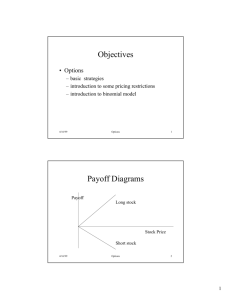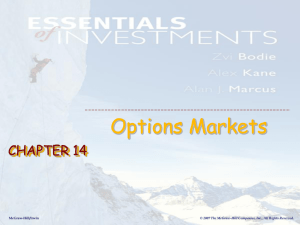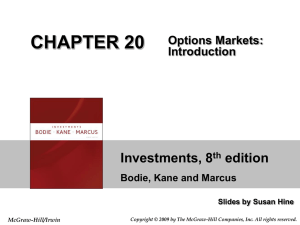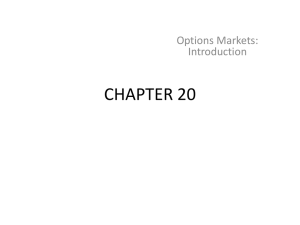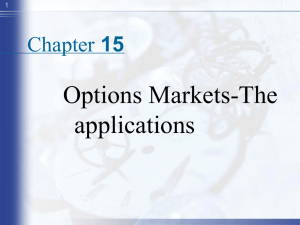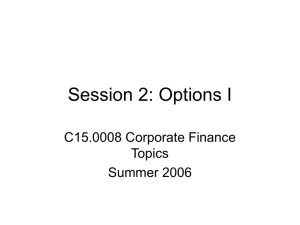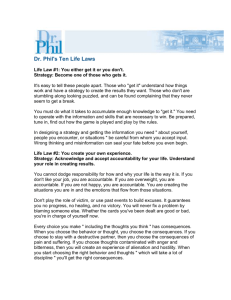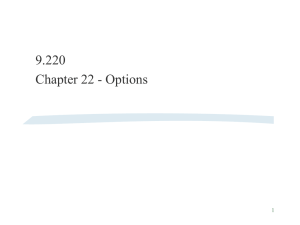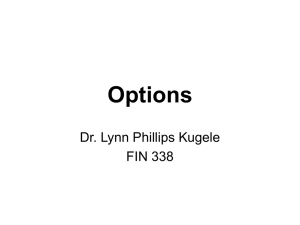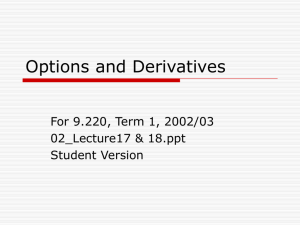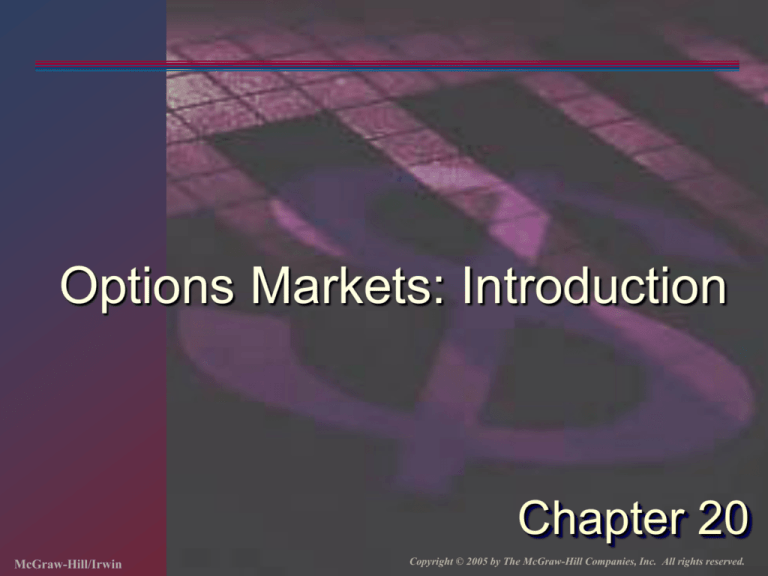
Options Markets: Introduction
Chapter 20
McGraw-Hill/Irwin
Copyright © 2005 by The McGraw-Hill Companies, Inc. All rights reserved.
Options
A call [put] option give the buyer the
right to purchase [sell] an asset for a
predetermined price (the strike or
eXercise price) through the maturity
date.
Options are only traded on volatile
stocks
These are side bets made on the price
of a stock and issuer of the stock has
nothing to do with the options markets
on its stocks
20-2
Option Terminology
Buy - Long
Sell - Short
Call
Put
Key Elements
Exercise or Strike Price
Premium or Price
Maturity or Expiration
20-3
Market and Exercise Price Relationships
In the Money – immediate exercise of the
option would yield a positive cash flow.
Call: market price > exercise price
Put: exercise price>market price
Out of the Money - exercise of the option
would yield a negative cash flow (so don’t
exercise).
Call: market price < exercise price
Put: exercise price < market price
At the Money - exercise price and asset
price are equal.
20-4
American vs. European Options
American - the option can be exercised
at any time before expiration or maturity.
European - the option can only be
exercised on the expiration or maturity
date.
20-5
Adjustments to Contract
If a stock splits there is a corresponding
adjustment to the strike price. In other
words, there is no difference in the
payoffs to an option due to a stock split
There is no adjustment for the cash
dividends that a stock pays
20-6
Different Types of Options
Stock Options – may have to deliver the
stock
Index Options – are settled in cash
Futures Options – options to buy future
contracts at the exercise price
Foreign Currency Options – right to buy
foreign currency at a specified price
Interest Rate Options – various interest
rate related on fixed income securities
or interest rate futures
20-7
Payoffs and Profits at Expiration - Calls
Notation
T= expiration date
Stock Price = ST eXercise Price = X
Payoff to Call Holder
(ST - X) if ST >X
0
if ST < X (the “optional” part)
Profit to Call Holder
Payoff - Purchase Price (or premium)
20-8
Payoffs and Profits at Expiration - Calls
Payoff to Call Writer (put a minus sign in
front of the payoff to call holder). The call
writer does not have an option – must
respond to the buyer of the option.
- (ST - X)
if ST >X
0
if ST < X
Profit to Call Writer
Payoff + Premium
20-9
Profit Profiles for Calls
Profit
Call Holder
0
Call Writer
X
Stock Price
20-10
Payoffs and Profits at Expiration - Puts
Payoffs to Put Holder
0
if ST > X
(X - ST)
if ST < X
Profit to Put Holder
Payoff - Premium
20-11
Payoffs and Profits at Expiration - Puts
Payoffs to Put Writer
0
if ST > X
-(X - ST)
if ST < X
Profits to Put Writer
Payoff + Premium
20-12
Profit Profiles for Puts
Profits
Put Writer
0
Put Holder
X
Stock Price
20-13
Equity, Options & Leveraged Equity
S0 = 100, X=100
Investment
Strategy
Investment
Equity only
Buy stock @ 100 100 shares
$10,000
Options only
Buy calls @ 10
Leveraged
equity
Buy calls @ 10
100 options
Buy T-bills @ 3%
Yield
1000 options* $10,000
$1,000
$9,000
*10 contracts of 100 options
20-14
Equity, Options Leveraged Equity - Payoffs
Ending Stock Price
$95
$105
$115
All Stock
$9,500
$10,500
$11,500
All Options
$0
$5,000
$15,000
Lev Equity
$9,270*
$9,770
$10,770
20-15
HPR - Rates of Return
IBM Stock Price
$95
$105
$115
All Stock
-5.0%
5.0%
15%
All Options
-100%
-50%
50%
Lev Equity
-7.3%
-2.3%
7.7%
See Figure 20.6 for plot of hpr’s
20-16
Option Strategies - Protective Put
Use – Portfolio insurance (limit loss)
Position - long the stock and long the put
Payoff
ST < X
ST > X
Stock
ST
ST
Put
X - ST
0
Portfolio
X
ST
20-17
Protective Put Profit (for X=S0)
Profit
Stock
Protective Put
Portfolio
X-(S0+P)
-P
ST
20-18
Covered Call
Use – To increase the yield of your stock
(by selling the call) when you think the
stock won’t go up in the short run.
Position - Own the stock and write a call.
Payoff
ST < X
ST > X
Stock
ST
ST
Call
0
- ( ST - X)
Portfolio
ST
X
20-19
Covered Call Profit (S0 = X)
Profit
Stock
Covered Call
Portfolio
ST
20-20
Other Option Strategies
Long Straddle (Same Exercise Price)
Long Call and Long Put
Useful if you believe the stock price will
move a lot, but you don’t know in which
direction
See Figure 20.10 for payoffs and profits
20-21
Other Option Strategies
Spreads - A combination of two or more call
options or put options on the same asset
with differing exercise prices or times to
expiration.
Vertical or money spread:
Same maturity
Different exercise price
Horizontal or time spread:
Different maturity dates
20-22
Put Call Parity – Consider a Ptf with 0 payoff
Action
CF today
ST < X
ST > X
Buy Stock
-S0
ST
ST
Buy Put
-P
X - ST
0
Sell Bond
Sell Call
Total CF
X/(1+r)
C
*
-X
0
0
-X
-(ST – X)
0
* = -S0 – P + X/(1+r) + C = 0
20-23
Put – Call Parity
-S0 – P + X/(1+r) + C = 0
Rewrite as:
P = X/(1+r) + C – S0
Where:
P=price of put
C=price of call
S = stock price today
X = eXercise price
r = risk free holding period return
20-24
Arbitrage & Put Call Parity
Since the payoff on a combination of
a long call and a short put are
equivalent to leveraged equity, the
prices must be equal.
C - P = S0 - X / (1 + rf)T
If the prices are not equal arbitrage
will be possible.
20-25
Put Call Parity - Disequilibrium Example
Stock Price = 110 Call Price = 17
Put Price = 5
Risk Free = 10.25%
Maturity = .5 yr
X = 105
C - P > S0 - X / (1 + rf)T
17- 5 > 110 - (105/1.05)
12 > 10
Since the leveraged equity is less expensive,
acquire the low cost alternative and sell the
high cost alternative.
20-26
Put-Call Parity Arbitrage
Position
Immediate
Cashflow
Cashflow in Six Months
ST<105
ST> 105
Buy Stock
-110
ST
ST
Borrow
X/(1+r)T = 100
+100
-105
-105
Sell Call
+17
0
Buy Put
-5
Total
2
105-ST
0
-(ST-105)
0
0
20-27
Optionlike Securities
Callable Bonds
Convertible Securities
Warrants (like call options, but issued
by firm, and lead to some stock
dilutions, though the firm receives the
strike price)
Collateralized Loans (value of the
collateral becomes the ST, and the loan
amount is the strike price)
Financially engineered products
20-28
Exotic Options
Asian Options – payoff depends on
average prices over a period
Barrier Options – payoff depends on
whether a price has crossed a barrier
Lookback Options – depends on max or
min price over a period
Currency Translated Options – asset or
exercise price denominated in a foreign
currency
Binary Options – a fixed payoff depending
on whether a condition is met
20-29

